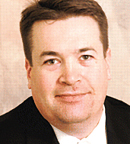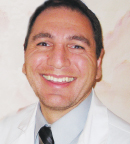
Christian Downs, JD
As new treatment decision-making tools make their way toward and into the clinic, oncologists are getting a sense of how they may affect clinical practice—and beginning to look farther down the road.
“What do you see ahead for clinicians?” asked Christian Downs, JD, Executive Director of the Association of Community Cancer Centers (ACCC), who moderated a panel on the new tools at the group’s annual meeting in Washington, DC. “What kind of infrastructure will be needed to support these tools?”1
Tools to help compare the benefits, risks, and costs of cancer treatments are being developed by various organizations [see “NCCN Working Group on Value Tools Presents Preliminary Findings and Recommendations,” The ASCO Post, February 10, 2017].
Some, like ASCO’s Value Framework and the NCCN Clinical Practice Guidelines in Oncology (NCCN Guidelines®) with NCCN Evidence Blocks™, developed by the National Comprehensive Cancer Network® (NCCN®), are designed specifically to help patients and physicians discuss, and take into account, the individual patient’s values regarding outcome, toxicities, quality of life, and cost.
Looking ahead 10 years, panelists saw these tools affecting and being affected by other trends in clinical practice, including greater access to real-world data; the increasing use of next-generation sequencing; and the growing complexity of decision-making as the available data expand and treatment options become more numerous and personalized.

Ali McBride, PharmD
We are moving into unknown territory. We need more data, more discussion.— Ali McBride, PharmD
Tweet this quote
Explosion of Data
One trend that will bear directly on value-based decision-making is the development of real-world data, panelists agreed. Clinicians will have access to large databases, such as ASCO’s CancerLinQ®, with data derived from multiple oncology practices and thousands of electronic health records.
Real-world data will supplement the data from clinical trials and provide oncologists with more and better information for discussions with patients, said Ali McBride, PharmD, of the University of Arizona Cancer Center. It could show, for instance, whether elderly patients, who are rarely included in clinical trials, do as well on a particular drug as younger ones. Patient-reported outcomes, including data on toxicities and quality of life, could be more available and accessible.
Clinicians will have more information to work with as they guide patients through the decision-making process, agreed Stephen S. Grubbs, MD, Vice President of ASCO’s Clinical Affairs Department. More real-world data will also be available on all treatment-related costs, and payer data may be melded with clinical data. Medicare is already working on doing this with some of its advanced payment models, Dr. Grubbs said in an interview.

We want to identify key endpoints—those that are most meaningful to patients.— Stephen S. Grubbs, MD
Tweet this quote
Also part of the mounting data to be factored into decision-making will be the results of next-generation sequencing, panelists said. With the ability to identify gene alterations and other biomarkers more easily and less expensively than ever before, laboratories are also identifying “druggable targets.” And some of them are in cancers for which the drug has not been tested yet, raising issues of off-label prescribing, said Dr. McBride. “We are moving into unknown territory,” he said. “We need more data, more discussion.”
Does all this mean that the oncologist’s role will be different in 10 years? Not fundamentally, said Dr. Grubbs. The provider, as always, will be educator and advisor. “But we will have more information to work with to help the patient come to an informed decision,” he said. And the whole oncology team, including physicians, nurses, navigators, and financial experts, will be increasingly important in that process.

There’s an explosion of information that has to be considered to take care of any one disease…. We will all need to be sub-sub-subspecialists.— Robert Carlson, MD
Tweet this quote
In fact, physicians will need to be more engaged than ever, said Robert Carlson, MD, Chief Executive Officer of NCCN. Treatment decisions will be more complex, with new and emerging biomarkers to consider as well as a plethora of new agents and therapy types. There’s an “explosion of information that has to be considered to take care of any 1 disease,” he said in an interview, noting that oncologists often see 6 or more tumor types in 1 day.
As a result, there will be more and more specialization. The academic world is already experiencing this trend, which is now spreading to the larger cancer centers and will soon reach community practices, he said. “We will all need to be sub-sub-subspecialists.”
Dr. Carlson also said he expects to see the development of computer programs to support decisions about treatment. They could help patients explore and understand their own value systems “so that they can be incorporated intentionally into their decision-making process.” Such programs might be tools that patients could use and return to over time—both before and after a discussion with their physicians, for example.
Continuing Development
In the meantime, the new tools continue to be developed, expanded, and refined. The NCCN Guidelines® with NCCN Evidence Blocks™ provide a graphic showing experts’ ratings of systemic therapies in five areas—efficacy, safety, quality and quantity of evidence, consistency of evidence, and affordability. They had been completed for 33 different cancers at the time of the meeting and will be available for all NCCN Guidelines® by the end of the year.
Feedback on the tools has been positive, Dr. Carlson said. Surveys show that providers find them useful, and payers have talked to NCCN about incorporating them into their own treatment pathways. Next steps will be to develop NCCN Evidence Blocks for the network’s radiation therapy and surgery recommendations. Discussion of these tools is already underway, he said.
ASCO’s Value Framework, still under development, is being refined in various ways. This tool compares the clinical benefits and side effects of regimens that have been tested head-to-head in clinical trials and calculates a numerical “net health benefit” based on survival and toxicity data. Costs are presented beside the net health benefit.
One need is for improved methodologies, Dr. Grubbs said, including a better method for making cross-trial comparisons—comparing two drugs that, though not tested head-to-head in a trial, were both compared to the same third drug in different trials. Another refinement will be to anchor the net health benefit scores in a more meaningful way, for example, by including evidence on minor as well as major toxicities and evidence from patient-reported outcomes. A validated assessment method will be developed as well.
Also high on this project’s list of goals is continued patient engagement. “We want to identify key endpoints,” Dr. Grubbs said, “those that are most meaningful to patients.” ■
DISCLOSURE: Dr. Carlson is an employee of NCCN. Drs. Grubbs and McBride reported no conflicts of interest.
REFERENCE
1. Value-based frameworks: Everything your cancer program needs to know. 2017 ACCC Annual Meeting. Presented March 30, 2017.

